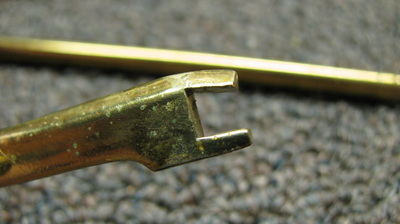The Little Stuff Makes A Big Difference
This 1941 Conn 10M is in my woodwind repair shop in Seattle. The previous repair tech crunched the tabs on both the side Bb and C keys. Why? To eliminate lost motion between the the lever and the key. Lost motion is when a lever or key designed to open or close another key does not do so instantaneously: The keys should act as one.
When there is lost motion they feel clumsy, clunky, and reduce the players confidence in their horn. If the adjustment materials are too thick, or create unnecessary friction, the key will bind. If the adjustment materials are too hard, the key work will make annoying clicking sounds. If the materials are the correct thickness, act as good bearing surfaces, and are soft enough to absorb sound, the key work will act as one, feel slick and responsive, and be silent.
Here is a short chronology: Lost motion is usually the first indication that your adjustment materials have compressed and worn down over time. Your horn will often play adequately even if there is lost motion. It will just feel clunky, but when the discrepancies increase, playability issues will surface, and that's when you end up in the repair shop.
This 1941 Conn 10M is in my woodwind repair shop in Seattle. The previous repair tech crunched the tabs on both the side Bb and C keys. Why? To eliminate lost motion between the the lever and the key. Lost motion is when a lever or key designed to open or close another key does not do so instantaneously: The keys should act as one.
When there is lost motion they feel clumsy, clunky, and reduce the players confidence in their horn. If the adjustment materials are too thick, or create unnecessary friction, the key will bind. If the adjustment materials are too hard, the key work will make annoying clicking sounds. If the materials are the correct thickness, act as good bearing surfaces, and are soft enough to absorb sound, the key work will act as one, feel slick and responsive, and be silent.
Here is a short chronology: Lost motion is usually the first indication that your adjustment materials have compressed and worn down over time. Your horn will often play adequately even if there is lost motion. It will just feel clunky, but when the discrepancies increase, playability issues will surface, and that's when you end up in the repair shop.
So, how to get rid of it? You could do what was done in these photos. Just crunch those tabs to make up for the worn out adjustment material and send the musician on their way. This could result in:
-Obviously unparallel key tabs which are ugly as hell and look like someone didn't care enough to do the job right.
-Compressed height adjustment material under your Bb key. Which is unsightly and will increase the key stroke, producing a sharper Bb. It will also make the key bind before it bottoms out on the body tube.
-Plier marks on your Bb key.
Look at the two pictures above. The angled tab on the Bb key even wore down the lever. It has a taper on its south side. Compare it with the picture below: That is a 1947 10M. See the corners on that lever? That is how it should look.
-Obviously unparallel key tabs which are ugly as hell and look like someone didn't care enough to do the job right.
-Compressed height adjustment material under your Bb key. Which is unsightly and will increase the key stroke, producing a sharper Bb. It will also make the key bind before it bottoms out on the body tube.
-Plier marks on your Bb key.
Look at the two pictures above. The angled tab on the Bb key even wore down the lever. It has a taper on its south side. Compare it with the picture below: That is a 1947 10M. See the corners on that lever? That is how it should look.
Setting the adjustment materials so they eliminate all lost motion and silence all the key work is time consuming. When I worked in a corporate repair shop, taking the time to do it the way I have done here is exactly the kind of thing that would have resulted in a Repair Department Meeting in which we would all be pressed to get work done faster. This is why repair techs do what was done in the first photo. They are either pressed to do so, or they have been trained to do so and don't know any better.
Of course, sometimes, the client has made their inability to pay for a proper repair clear and has been told explicitly by the repair tech that corners will be cut. But that topic requires a lengthy article all to itself.
Of course, sometimes, the client has made their inability to pay for a proper repair clear and has been told explicitly by the repair tech that corners will be cut. But that topic requires a lengthy article all to itself.


